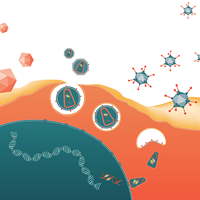Alpharetroviral self-inactivating vectors: an emerging tool for gene therapy
Cell Gene Therapy Insights 2016; 2(5), 623-627.
10.18609/cgti.2016.070
Your research has predominantly focused on the development of retrovirus–based vectors, as gene transfer systems for gene therapy. What do you see as the advantages of using these vectors for gene therapy compared to adenoviral vectors?
Retrovirus-based vectors are vector tools that integrate preferentially into actively transcribed regions of the genome, from where the introduced genetic information can be permanently expressed. diseases, in which we would like to achieve a long lasting treatment effect. For example, retrovirus-based vectors, including gammaretroviral and lentiviral vectors, have a proven track record in the clinical arena. Gene therapy strategies using retrovirus-based vectors have been successfully used to treat immunodeficiencies, such as forms of severe combined immunodeficiency, globinopathies, such as sickle cell disease and beta thalassemia, and metabolic diseases, such as metachromatic leukodystrophy and adrenoleukodystrophy. In these diseases, it is possible that a one-time treatment could lead to a lifelong therapeutic effect. Evidence has shown that coupling hematopoietic stem cell transplantation and gene therapy of hematopoietic stem cells can result in a remarkable and long-lasting therapeutic effect for the aforementioned diseases.
In contrast, adenoviral vectors, which also represent interesting and clinically useful tools, have a natural tropism towards different tissues, such as the liver and endothelial cells. Thus, adenoviral vectors are also suitable for in vivo delivery. The biggest difference to retrovirus-based vectors is that adenoviral vectors are episomal vectors, which means that they are almost exclusively maintained in an extra-chromosomal, non-integrated fashion. Thus, the therapeutic adenoviral vectors may become diluted over time in rapidly dividing cell populations.
A potential limitation of adenoviral vectors is that immunological responses have been reported in patients, which is likely attributed to the fact that adenoviruses are frequent causes of respiratory tract infections in humans. In summary, retrovirus-based vectors and adenoviral vectors are both very interesting tools in the arena of gene therapy. However, the decision of which vector type is best suited should be decided on a case-by-case evaluation as needed for the specific gene therapy intervention.
What are some of the challenges associated with using retrovirus vectors?
In general, genetic modification with viral vectors, and in particular the stable integration of a gene therapy vector into the host cell genome, is considered to be a potential risk. In that regard, the greatest concern is genotoxicity, which is a form of insertional mutagenesis facilitated by either enhancer-mediated dysregulation of neighboring genes or by initiation of aberrant splicing.
To address this issue, stringent deletions of the promoter/enhancer regions from long terminal repeats (LTR) were accomplished and resulted in development of improved retrovirus-based vectors, which are called self-inactivating (SIN) vectors. These SIN vectors have a reduced likelihood of cis-activation of genes due to viral integration and represent an important milestone toward reduction of genotoxicity, especially when lineage-specific or more physiologic internal promoters are used to drive expression of the therapeutic transgene.
In this context, it’s also worth mentioning the need to further develop meaningful genotoxicity assay systems for improved and simplified assessment of genotoxic risk as well as to predict safer gene therapy vectors at an early stage in (pre)clinical development.
Further potential risk factors, including the immunogenicity of vector particles, the phenotoxicity of the transgene – for example a toxic gene product – as well as potential vertical or horizontal transmission by so-called replication-competent retroviruses, RCR, should also be considered and excluded to ensure an acceptable safety profile.
One additional challenge is the current bottleneck for clinical-grade lentiviral vector production, from which one GMP-grade vector production is only sufficient to treat 2–3 patients.
You recently published an update on your exciting work in developing an alpha retrovirus self-inactivating vector platform, could you share the science behind the creation of these vectors?
Alpharetroviral vectors are a very promising new addition to the retroviral vector toolbox. hese vectors are derived from the Rous sarcoma virus, a retrovirus identified in 1911 by Peyton Rous and coworkers. Since it was already identified more than 100 years ago, the Rous sarcoma virus is currently one of the best studied retroviruses.
In contrast to gammaretroviral and lentiviral vectors, this avian retrovirus exhibits an intrinsically more random integration pattern into the host genome. This was especially interesting for us as this means that the alpharetroviral vectors have a reduced tendency to integrate close to transcriptional start sites or transcription units, and is thus less likely to interfere with these genomic features.
The initial generation of the alpharetroviral vector was challenging, because it was only known to be producible in avian cells. We re-designed this system, used codon-optimization to improve its performance in human cells and adapted it for production in human packaging cells, which is desirable for use in a clinical setting.
Furthermore, we developed a SIN (self-inactivating) vector design and removed cryptic splice sites to decrease the risks of genotoxicity. As the final step, we generated a so-called split packaging system for our vector, in which structural proteins, replication enzymes as well as envelope glycoproteins were encoded by separate plasmids, thereby decreasing the risk of replication competent retrovirus (RCR) formation
You specifically looked at using these vectors in T-cell and NK cell engineering. What were the key outcomes of this study?
T lymphocytes, natural killer (NK) cells and NKT cells are very interesting cell populations for immunotherapeutic approaches. For example, the application of T-cell receptor genes, chimeric antigen receptors and suicide genes to prevent graft versus host disease (GvHD) are a few of the clinical strategies currently being developed.
We found that alpharetroviral vectors are very well suited to transduce human T-cells and human NK cells. For NK cells, it is often very difficult to reach high transduction efficiency using low or moderate vector doses. Use of the alpharetroviral vector system allowed us to achieve very high transduction rates using a low vector dose.
We tested different clinically relevant transgenes, such as chimeric antigen receptors and suicides genes (for GvHD prophylaxis), and obtained proof-of-principle that these transgenes performed as expected in human T and NK cells. Moreover, we established a stable packaging cell line technology, which robustly produced alpharetroviral SIN vectors with high titers for more than 6 months, which is quite remarkable. This is interesting from a manufacturer standpoint, as this allows generation of high titer stable producer clones.
Taken together, these vectors are very interesting as – using this improved and cost-effective stable production system – we envision that vector scale-up would be simplified and more patients could be treated. Furthermore, in the ideal setting, one would only need to create one large batch of alpharetroviral vector and, thus, only have to test it once in terms of preclinical vector characterization to meet the requirements instructed by regulatory agencies.
How could these vectors be manipulated to further enhance their therapeutic potential?
These vectors are already fairly well advanced retroviral vector tools, due to the several optimization steps and synthetic biology approaches that were applied to improve their clinical behaviour. Previous work from us and others have resulted in vectors that have an improved and partially synthetic design, with no cryptic splice sites and no overlap of gag/pol (encoding structural proteins and replication enzymes) or env (envelope) sequences.
We also incorporated further features such as codon optimization and improvements in post-transcriptional processing, to ensure efficient expression of the therapeutic gene.
Certainly, further fine tuning of vector expression to mimic physiologic expression is required for each new clinical application strategy. To accomplish this, one could incorporate more physiologically relevant promoter sequences and miRNA sponges to drive transgene expression and to restrict expression in more physiological terms.
Additionally, one could also consider use of improved vector pseudotyping and equip these vector tools with new envelope variants, e.g. the recently described antibody- or darpin-guided Measles or Nipah Virus systems developed by Christian Buchholz at the Paul Ehrlich Institute in Langen. One could envision using these tools to achieve cell specific targeting in vivo and potentially even more applications.
What do you see as the major challenges in moving this and other new vectors towards clinical translation for future human gene therapies?
First of all, we have obtained proof-of-principle that we can generate a stable human packaging cell line and validated the vector system in murine and human hematopoietic stem cells as well as human T cells after transplantation in suitable mouse models. That’s very interesting.
As a next step, we are now in the process of generating a fully traceable stable packaging line and, in collaboration with David A. Williams (Chief Scientific Officer, Boston Children’s Hospital), we are designing additional strategies to approach several clinically interesting diseases.
We do not foresee major bottlenecks, and have already developed a plan to move this promising technology into the clinical arena.
As for the field in general, it would be desirable to have further improvements in the preclinical pipelines and the efforts to bring an interesting therapeutic and safe approach closer to clinical use to benefit the patients. Therefore, it is important that we as a scientific community develop better tools for the risk-benefit assessment of our vector tools, and also to streamline the procedures required to move interesting research from bench to bedside, i.e. into a clinical trial.
It will certainly be necessary to form teams consisting of experienced clinicians and knowledgeable scientists in order to translate these strategies more efficiently into clinical reality in settings where there is a high unmet clinical need.
One final and important point that certainly deserves more attention is how to form productive general alliances with industrial partners and to identify win–win settings to streamline development of clinical gene therapy procedures into promising and safe drugs for the benefit of patients.
Affiliation
Dr Axel Schambach
Acting Director of the Institute of Experimental Hematology at Hannover Medical School, Germany

This work is licensed under a Creative Commons Attribution- NonCommercial – NoDerivatives 4.0 International License.

